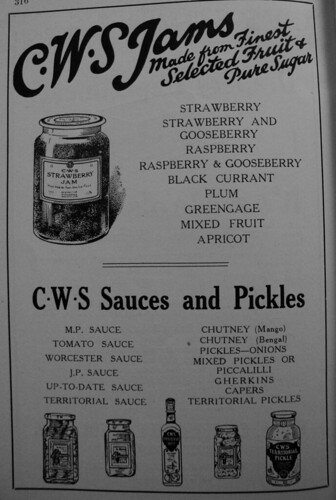
A relish from the Raj that made its appearance in Britain at the end of the 18th Century in the upper class households, and was adopted by successive classes to become a national condiment. Now every grocery store, faux farm shop, pseudo farmers market and delicatessan stocks the stuff.
Hobson Jobson, Yule & Burnell's 1886 glossary of Anglo-Indian words, cites chatna from 1813 and chatnee from 1820. From which you get the modern English spelling chutney. If you were wealthy enough you could buy imported chutney, or get cook to rustle up a batch that used apples and onions instead of mangoes and tamarinds. Recipes in Eliza Acton's Modern Cookery for Private Families ( 1845) or Mrs. Beeton's Household Management (1861).
Moving on a bit prices fell, and production from every pickle and sauce maker increased. Here we have the CWS advert from 1926 which has a Bengal chutney (that's short hand for hot, just like the description Mexican these days), and a mild sweet mango chutney.
Green Label Mango Chutney by Sharwood's become one of the leading brands after WWI and it still is. You'll find in The Co-Operative store and just about everywhere else. Just check out the illustration from the 1920's. It might have been made in a factory in London but you've got a character out of the Arabian Nights giving it authenticity. Heinz made a tomato chutney - tomatoes were their ingredient of choice for ketchup, soup and beans. Crosse & Blackwell were also leading purveyors.
I do like some of the names the evoke the colonial period, still available when you track them down. Major Grey's Mango Chutney was supposedly named after some chap in the Bengal Lancers. The best is Colonel Skinner's Mango Chutney, now he was a real soldier in India with his own horse regiment.
Now I've tried to explain chutney to friends from the other European countries. They look puzzled when I explain it is like a spicy jam and goes particularly well with poppadoms or as an extra filling for a sandwich.
However what was once an exciting new food from the Jewel of the Empire has been adapted to modern tastes. That is sweet and homogenised. Loaded with cheap sugar from beet, and there are brands out there are using high fructose corn syrup, having a texture that is gloppy sticky paste. When you see it in squeezable plastic containers you've hit another nadir in good taste. When you get the watery let down served in restaurants you've been done again. Don't fret there are still good chutneys about.
On the home made chutney front it became the salvation for the glut of fruit and vegetables. Back in WW2 days the Ministry of Food issued information to make Green Tomato Chutney. It had been around for decades because unripe tomatoes are that blessing or curse of English summers. The adoption of a foreign food to become an institution is a fascinating development and we should be pleased it has happened. Why eat plain when there is a jar of chutney in the cupboard.
Links for further reading :
Hobson Jobson : Anglo-Indian dictionary online.
Military memoir of lieut.-col. James Skinner is available at the Internet Archive, but only the Google Books version appears to have all the pages. It's here.
Previous posts in the Foods of Empire series are these.

3 comments:
Hey :) where did you got those pictures from? I'd really like to use them in my thesis about chutneys. would that be possible? :)
hey, post your thesis about chutneys!
I'd really love to see your thesis about chutneys, as I'm working on a class about them.
Post a Comment